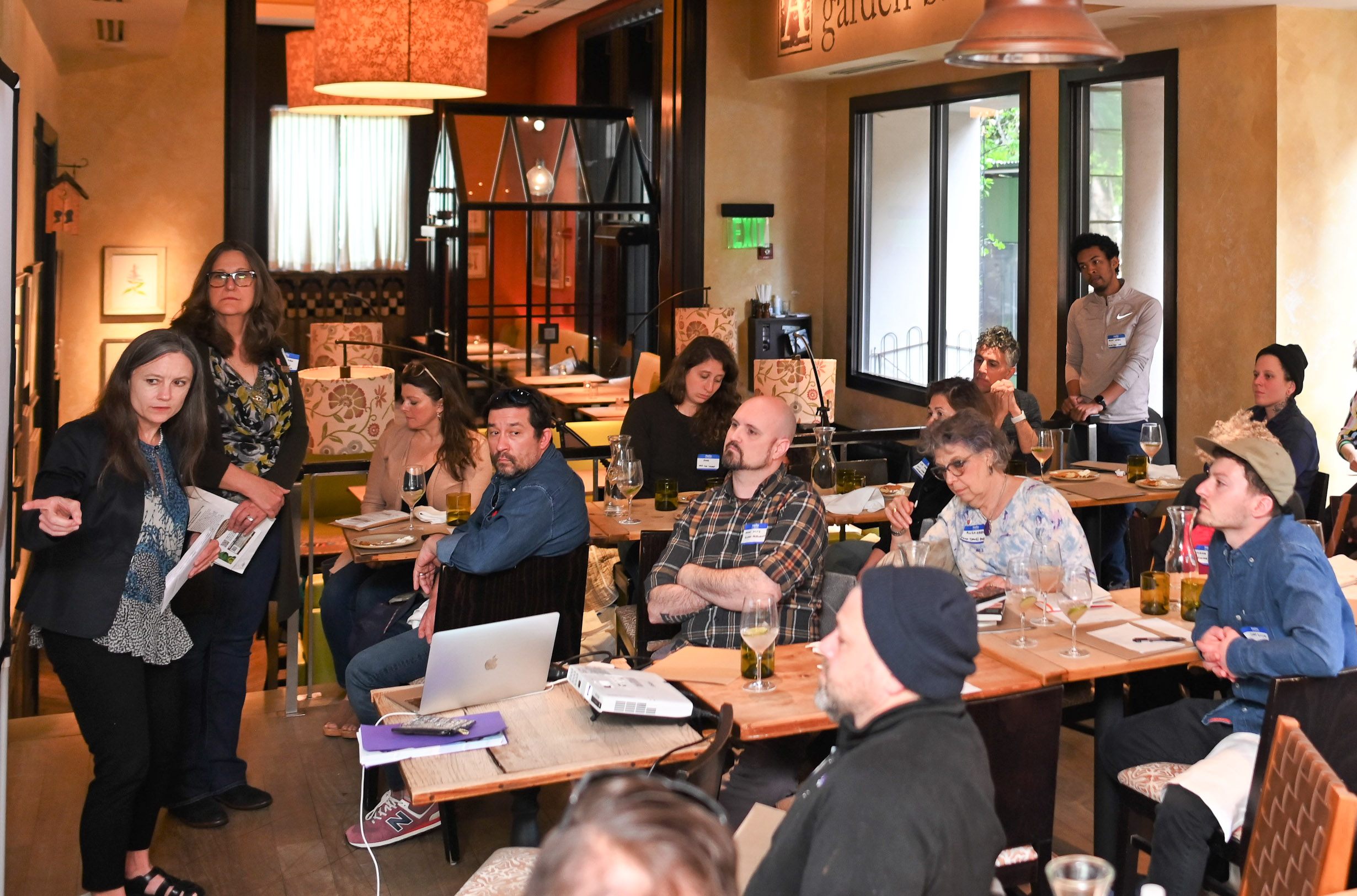Chefs have a unique role in the seafood supply chain: retailer, wholesale buyer, culinary artist, office manager, accountant. Importantly, they are also educators, teaching both staff and customers about where the food they serve comes from and why that matters.
That’s not always easy, especially for chefs sourcing seafood from distributors that don’t provide much visibility into the backstory of the seafood they deliver.
This was one of the key topics we explored during the Slow Fish Rising Tide Chefs Camp held in Philadelphia on April 24, hosted by Slow Food Philly and Talula’s Garden. Nearly 35 chefs, restaurateurs, business owners, distributors, food writers, and seafood advocates shared their expertise while diving deep into conversations about what sustainable seafood looks like and how to source it.
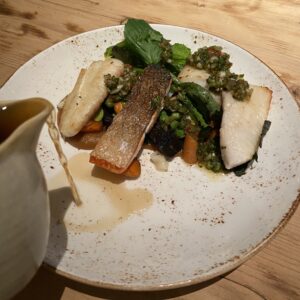
Chefs Camp better have some good, locally sourced, sustainable seafood. Left to right, Wild for Salmon black cod and sockeye salmon and Fishadelphia fluke.
Chefs shared some of the challenges they face in sourcing sustainable seafood, including the need for better supply chain visibility, variable seafood quality from distributors and fishermen, the barrage of messaging that wild fisheries are dead, and customers who are reluctant to try something new.
The Chefs Camp was a collaboration between Slow Fish North America, Slow Food USA, Slow Food Philly, Fishadelphia, Wild for Salmon, Cape May Salt Oyster Farms, and One Fish Foundation. We set out to curate a conversation about how chefs view sustainable seafood sourcing, the challenges they face, and what solutions they might explore to bring more responsibly sourced seafood to customers.
We all learned much in the process.
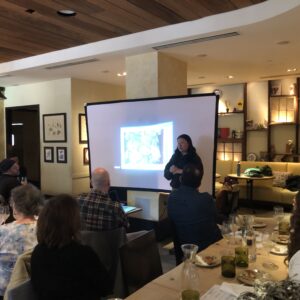
Feini Yin of Fishadelphia talks about the community supported fishery model of direct seafood delivery to consumers and restaurants.
Common challenges
The majority of chefs we spoke with share many of the Slow Fish/Slow Food values of providing seafood that is good (healthy, great quality), clean (from a well-managed, local, abundant stock) and fair (fishermen and crew get paid a fair wage, and the seafood is sold at a fair price). The challenge for some is consistently sourcing seafood that meets all of these values.
For example, several chefs expressed frustration with the lack of information about the fishery and the overall population health of the different species they get from their distributors. So we talked about the importance of shorter, more direct supply chains and building trust with suppliers. That also means pressing them for credible information about the story behind the seafood. The closer they get to the producer, the more they’ll know about the fish in their kitchen.
Chefs also discussed how they sometimes struggle with varying product quality from their distributors. Some use lower-quality products in stocks or soups or spreads while others acknowledge that they have to account for some level of waste.
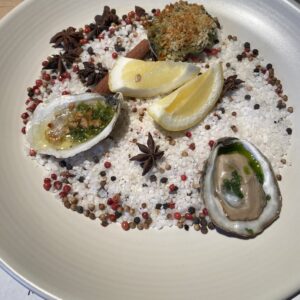
Oysters, three ways, courtesy of Cape May Salt Farms and Talula’s Garden chefs.
Speaking of waste, we also talked about the elephant in the room. Farmed Atlantic salmon is typically cheaper than wild salmon, and it’s often more accessible. But some chefs were surprised to learn the global farmed salmon industry produces 15% to 20% of waste per year. In 2022, that amounted to 435,000 tons or 870,000,000 pounds of wasted farmed salmon that died because of disease, sea lice infestation, low oxygen from overcrowding, and a host of other issues. We also discussed the ecological impact of feed, including crushing forage fish populations to grind up into pellets, or massive monocrop soy production for plant-based feeds that yield low Omega 3 benefits.
Chefs offered several suggestions to improve a slide we shared that showed a side-by-side cost-benefit comparison of farmed salmon and wild sockeye. Chief among those suggestions was to expand the comparison to other wild salmon species like king (Chinook), coho, and chum and also highlight different flavor profiles and textures. That kind of feedback is essential to refining the platform for future Chefs Camps.
We held up examples of aquaculture with values, such as bivalve and kelp farming as well as small-scale aquaponics, which use closed loop systems that don’t require much feed for herbivorous fish that benefit from the nutrients from water-grown plants like lettuce. Small-scale aquaponics also don’t have the effluent problem of large-scale land-based farms.
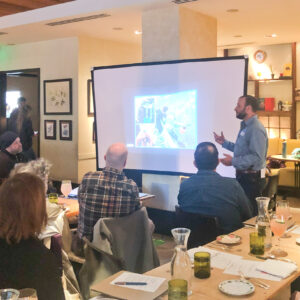
Steve Kurian of Wild for Salmon tells the story of the sustainable sockeye salmon fishery in Bristol Bay and working directly with chefs.
Finding solutions
Throughout all of these conversations we had honest, interactive dialogue about what chefs are experiencing, and what steps they might consider to change the dynamic in their own kitchens.
Some of the solutions we discussed included forging direct relationships with fishermen based on trust that encourages chefs to focus more on seasonally available seafood that fishermen provide. That could mean getting a call from a fisherman on the boat to learn about that day’s catch.
A distributor suggested shifting the predominant narrative from big multi-national corporations that aquaculture, especially farmed salmon, will feed the world. Instead, we should highlight the benefits of working with local, community-based fish harvesters and distributors who provide transparency about where the seafood comes from.
We talked about educating customers about seasonality and how to incorporate locally available, abundant species that customers may not know. That also means educating staff about how to tell that story. We shared the 7 C’s of Sustainable Seafood as a potential reference point for customers and staff.
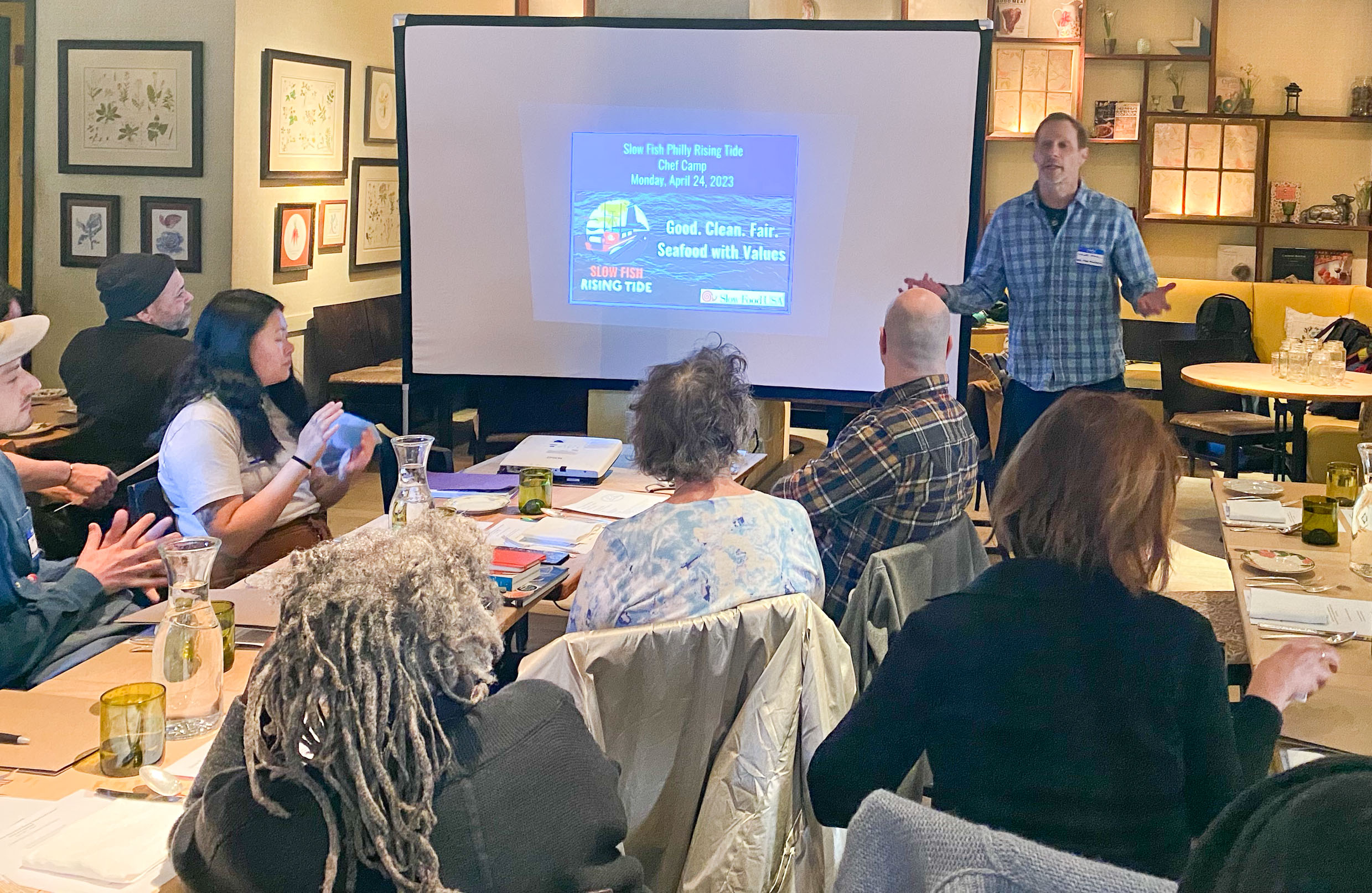
Carrying the message forward. Finding more ways to bring seafood with values onto menus.
This was the first of several important conversations. We’ll build feedback from this discussion into future Chefs Camps in other locations where we can gather culinary and seafood communities and talk about how we can foster local, transparent supply chains founded on shared Slow Fish values of good, clean and fair. We’ll work to adapt each conversation to each community’s unique set of challenges. We may not always find the perfect answer, but having these collaborative conversations is a significant first step, one conversation at a time.

Now you know what a “Fishwaffle” is. Delicious!
Huge thanks to Slow Food Philly, whose tireless effort to rally the chef community to attend was essential to making this first event a success. Also, big thanks to Fishadelphia, Wild for Salmon and Cape May Salt Oyster Farms for sharing stories of direct relationships with chefs for sourcing sustainable seafood.
Onward!
Top Photo: Slow Food Philly Co-Chair Jennifer Dolan talks about building community around food and seafood with values.


